It has always been popular to grow some flowers on allotments or veg plots either as crop flowers or as attractants for pollinators. Emma Rawlings takes a look at just a few examples.

There are some flowers that have always traditionally been grown on allotments as crop flowers either for cut flowers or for planting out in the flower borders once they reach a certain size. Obviously, these are not just for allotments if you have room on your garden veg plot.
There are also flowers that are grown on veg plots which will enhance the vegetable growing space by improving biodiversity and attracting more pollinators or pest predators. The flowers may also be edible which is a bonus.
The Crop Flowers
The following have traditionally been grown on allotments and used to be more commonly grown although some gardeners still grow them, and it is definitely time for a revival.
Dahlia

These require a fair bit of space and are often seen dotted in flower borders these days but they have been, and still are, grown en masse on allotments either for exhibiting or just for cut flowers. The sheer number of varieties available and the beauty of these majestic blooms in late summer make these a great addition if you have room. If you garden in cold, exposed areas or have clay soil, tubers are best lifted in autumn after the first frost has cut the foliage back, and the tubers stored in dry compost under cover over winter.
Gladioli
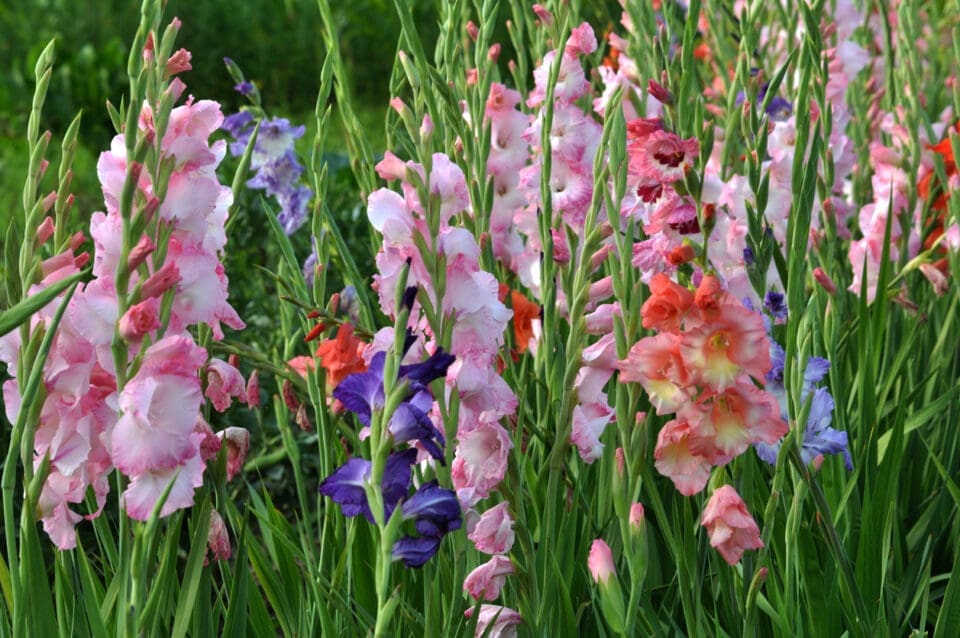
These have been rather out of fashion but they are starting to become more popular again. They are also called sword lilies which is apt due to their huge spikes of flowers. Three large stems of gladioli in a vase in the house will certainly cause a talking point. They are just so exuberant and, like dahlias, come in so many colours and different flower sizes and shapes.
They are easy to grow and fairly trouble free if you have free-draining soil and a sunny spot. Plant direct in the soil from May-June. You could devote rows to grow the corms and leave them in the ground. If you live in colder areas of the country or have clay soil, you could start off in pots (terracotta or aquatic pot plants) and plunge the pots in the ground when they have started into growth. Use peat-free compost and if you have some sharp sand or grit add some of this to the compost. The very tall varieties may benefit from some string supports between wooden stakes. When they have finished and died back lift them and place somewhere sheltered for the winter and then repot and plunge them back in the soil again the following spring.
Wallflowers
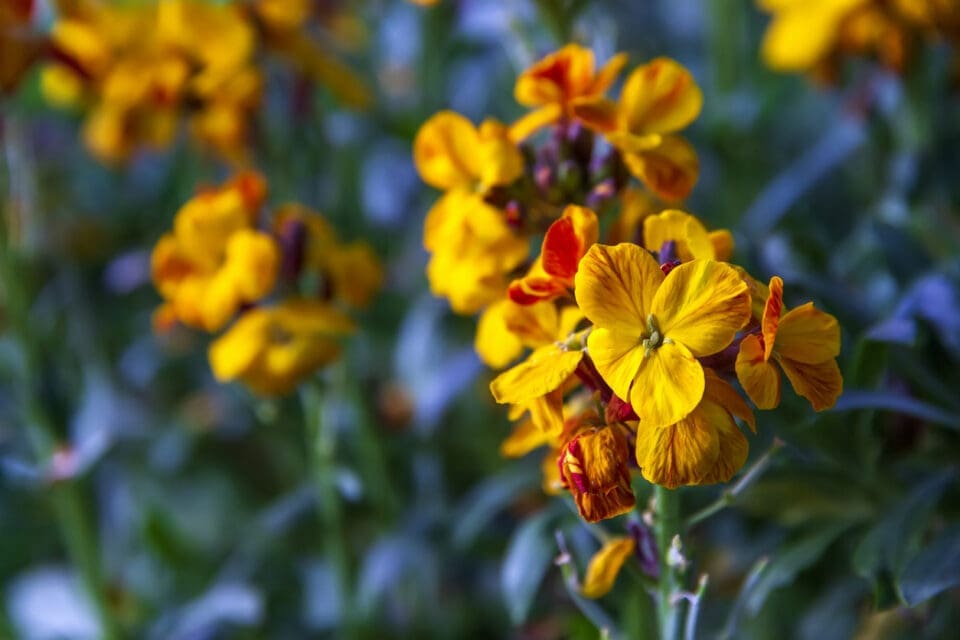
These are similar to sweet Williams in that they were traditionally started on the allotment sowing in rows during May to June and then transplanted as young plants in autumn into the flower border. They are often planted with spring bulbs as they flower at the same time and complement each other.
Wallflowers are in the same family as your cabbages so they like a more neutral to alkaline soil and because they are in the same family, they can suffer from the same pests and diseases, especially club root. If this is a problem in your soil, then avoid growing in the ground and start off in containers.
Now is a good time to buy wallflower plants from nurseries and some markets may still sell bare-rooted packs of plants ready for planting out.
Sweet Williams

These are related to pinks and carnations and treated as biennials so are sown in early summer and then they will flower the following May/June. They come in wonderful shades of pink, white, purple and red and some have different coloured centres and they also have a lovely scent. They make fantastic cut flowers or just planted out in the flower border to give some late spring to early summer colour. Traditionally, they are sown off in rows on spare ground on the allotment or veg patch in May or June and when the seedlings are through they are thinned to about 20cm (8in) apart. In September they can be lifted and planted in the flower border or leave where they are on the plot and harvest as cut flowers the following spring.
It is a good time to source young plants of sweet Williams to plant out. Check out garden centres and nurseries.
Sweet Peas

It is a great time to buy seed for sweet peas to sow next month. Look in the seed catalogues and at garden centres and pick some colours you fancy. If scent is really important look out for the old-fashioned varieties and you often find packets of seed which will produce mixed colours of sweet peas.
They can be sown in small 9cm (3½in) pots of compost. Sow 6-8 seeds per pot and you can either split them up when planting out or plant as a clump. You can also sow individual seeds in toilet roll tubes or in special deep cell trays.
Place on a greenhouse bench or in a conservatory or cold frame and grow on in this cool yet sheltered environment over winter. You can nip the tops off when they get to about 15cm (6in) high and they should bush out. Plant out in March or April where they are to flower.
Flowers To Benefit Crops
The following are flowers which may benefit your fruit and veg crops either by drawing in predators to control pests or to attract pollinators. Some may also be edible.
Cosmos
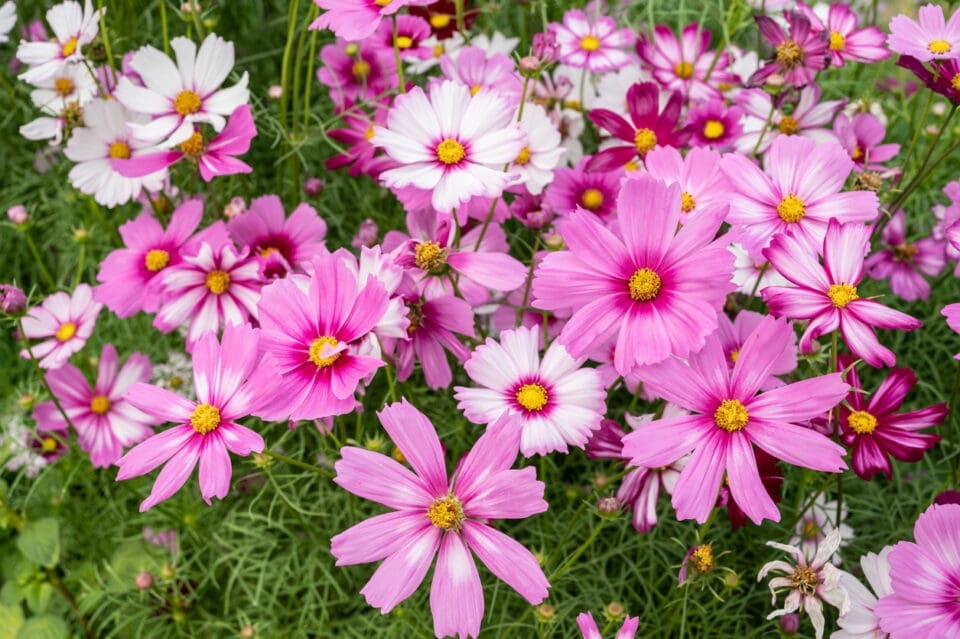
Annual cosmos are wonderful to grow on the plot and the single-flowered types are particularly good at attracting pollinators. In milder areas sow direct where they are to flower in early spring, about April time. You may get better results if you sow in small pots or modules and place on a greenhouse bench or in a conservatory or porch to grow on. Plant out when they are large enough (about 20cm/8in tall).
Calendula

These flowers come in bright orange but also pale orange and even cream and pastel yellow. They are easy to grow and will self-seed so you may have them popping up the following year. They are hardy annuals and can be sown direct where they are to grow in April. They may attract pollinators to the plot and the petals are also edible.
Nasturtium

These have bright, fiery colours and some will trail and scramble, making them ideal for planting at the edge of containers or raised beds. The leaves and flowers are edible, having a peppery flavour.
They are hardy annuals and have large seeds so are easy to plant by pushing seeds into the ground where you want them to grow in April and May.
Poached Egg Plant

It is an apt name as the flowers have yellow centres and white edges so they look like a poached egg. Its Latin name is Limnanthes douglasii and it is a hardy annual. If you only grow one flower on your veg plot then make it this one as it really attracts a lot of pollinators and insect predators. It is a low growing edging plant so can be squeezed around the edge of any size plot.
Sunflowers
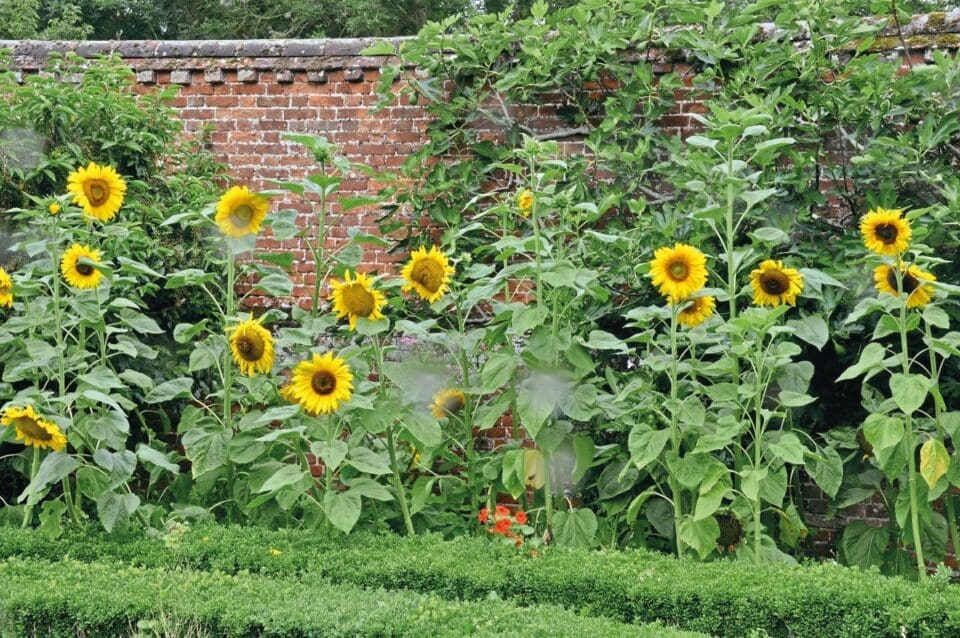
These always look cheery on a veg plot and are easy to grow. Sow them March to April in small pots of multipurpose compost and grow on a windowsill or a greenhouse bench. When they are a decent size (10-15cm/4-6in tall) plant out in a sunny, sheltered spot. Add some garden compost or manure before planting. Use your favourite slug control method as they love sunflowers. Once the plants get established and taller they tend to be bothered less by the pests. When the flowers arrive they will attract pollinators and the developing seeds can be left for the birds.
You can get red and even cream coloured ones now and dwarf ones too. Some will incline to bush out as they grow, producing shorter plants but more flower heads.
Marigolds
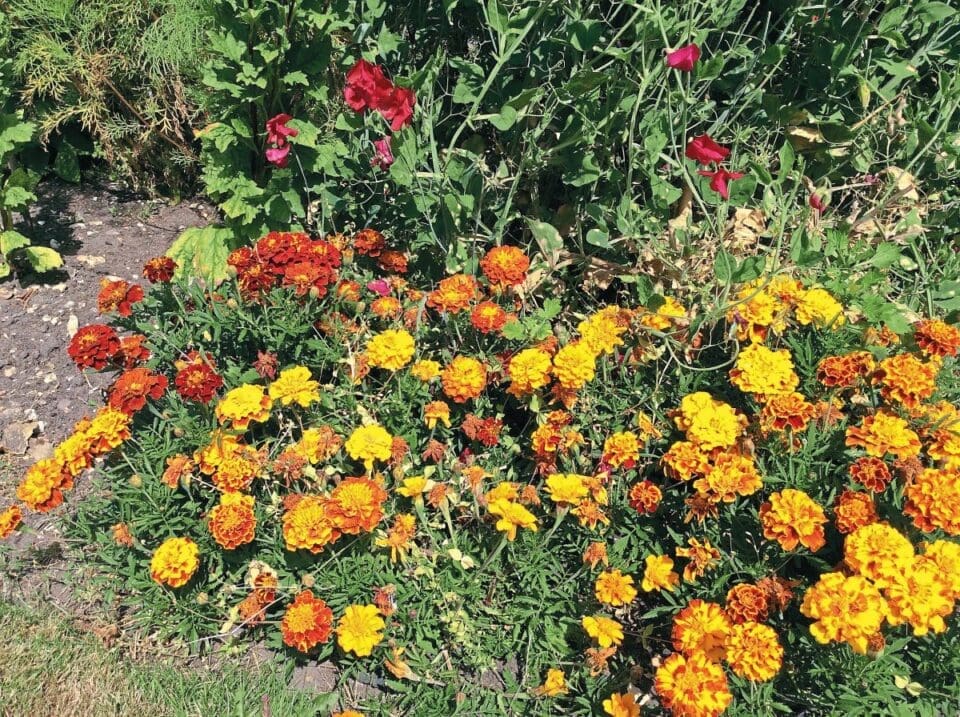
Traditionally grown at the base of tomato plants to keep whitefly at bay, these are really cheery little flowers, mainly yellow and orange with some variations on shades. They attract pollinating insects as well as having a strong aroma which can deter some insects or at least confuse them and maybe help keep pests away from crops grown adjacent to the marigolds. The largest group in the marigold family is tagetes and these are half-hardy annuals, meaning the seeds are sown in spring but under cover first as they need some warmth to germinate the seeds and in their early stages of growth. After the danger of frost is past, they can be planted out. Tagetes erecta (African marigolds) are taller and Tagetes patula (French marigolds) are usually short, up to about 30cm (12in) high, and have some lovely coloured double flowers.




